Getting a new puppy can be one of the most exciting events in a person’s life. Still, it can also be daunting with the amount of information you need to know and the things you need to buy to have everything ready to greet your new family member.

So how do you take care of a puppy from eight weeks of age to a year? Taking care of a new puppy includes the following:
- acclimating it to its new environment
- making sure it is housebroken, trained in obedience, and socialized
- providing reliable sources of nutrition
- providing veterinary care
- providing grooming supplies, toys, and other accessories
If you learn a little bit about the process of getting a puppy and raising it before it shows up at the house, you’ll be one step ahead of the game towards raising a dog that is a friendly, well-behaved, and positive addition to the family. Keep reading to find out more about the process of raising a new puppy.
Table of Contents
Supplies Needed for a New Puppy
Before you even consider bringing a new puppy into your household, there’s a variety of different supplies you’ll need to have on hand to provide your new puppy with everything they’ll need to get a good start in life. Here is a checklist of the things you’ll need to get for your new puppy before they come home:
- Food and water bowls: Rather than focusing on a decorative bowl, simple metal bowls with a weighted bottom are best to prevent spills and chew marks from teething pups. For large breed puppies, it’s a good idea also to purchase a stand for their food and water so that you can elevate it as the puppy grows taller to help avoid neck strain as well as bloat.
- Dog bed: You’ll want a dog bed for the inside of the house that is as small as the puppy you’re bringing home. The reason for this is that puppies feel more comforted when they are snuggled up against things, so if you have a dog bed that is bigger than your puppy, you should add several small blankets or other items to enclose the space and make it cozier. Getting a bed with sides will help them feel more secure as well.

- Dog house: If your dog is staying outdoors for any portion of its life, you’ll need to be sure to have a dog house available with insulation to keep them comfortable in cold or rainy weather. If the weather drops below freezing, however, it should be brought indoors until the weather warms. Remember, the best place for a dog is the same place any other member of your family lives…inside.
- Crate: If your puppy is going to be an indoor dog, you’ll need to crate train him or her. A crate may seem cruel to people who aren’t used to raising dogs, but they are actually a useful training tool that can help keep your puppy from damaging the home when unsupervised while also giving them a safe place that can act as their home base.
- Pet gate: A pet gate can be a good idea with a new puppy. It provides a way for you to secure the puppy into certain parts of the house when you’re not able to directly supervise them, preventing accidents and allowing you to partition the dog onto a hard surface rather than carpet.
- Food and treats: You’ll want to make sure you have food and treats already ready for your puppy before you bring them home, and preferably a bit of food from the place you’re getting them so you can mix it in at first before gradually transitioning the puppy onto a new puppy food if you don’t intend to use the same brand they were weaned onto.

- Leash and collar: Since you’ll need to get your puppy used to a leash and collar quickly for training and ID purposes, you should make sure you have one ready for the puppy to come home. Avoid using a retractable leash. A standard leash is the safest for any breed of dog, even small dogs.
- ID tags: An ID tag is essential for your puppy. This way, he or she can be found if they slip out of the house or yard, and when you get your puppy’s vaccinations, putting the rabies tag on its collar will let anyone who picks the puppy up know that it complies with city vaccination laws. If you don’t like hearing two tags clang together, consider an embroidered collar with your phone number. I have this exact one for my dog, Hurley.
- Enzyme-based cleaning supplies: When you’re raising a puppy, not just any cleaning supplies will do if they have a housebreaking accident. Enzyme-based cleaners are designed to remove all smells associated with dog urine or feces that might otherwise encourage a puppy to return to the same spot and have another accident.
- Playpen: For smaller puppies, a playpen can be the best way to keep them safe and underfoot while they are getting used to their new surroundings and are small and fragile enough to be injured by clumsy feet.
- Bitter apple spray: Bitter apple spray is a chemical spray formulated to deter teething puppies from chewing on things other than their toys.
- Grooming supplies: Depending on what breed of puppy you get, you’ll need a variety of grooming supplies such as brushes, shampoo, toothbrush, cotton balls, ear cleaning solution, nail clippers, and scissors. Research your individual breed or puppy coat type to know precisely which grooming supplies your puppy will need.
Once you’ve got the supplies ready for your new puppy to come home, the next thing on your agenda should be to puppy-proof your house. Make sure that any room the puppy might use is checked carefully for any objects which might accidentally injure them if they get curious about them, such as electrical wires, poisons, breakable objects, and other household hazards.
Acclimating a New Puppy
When you first bring your new puppy home at eight weeks, chances are the puppy will be overwhelmed, not to mention missing its mother and siblings. As a result of this, your new puppy may act timid, frightened, or exhausted.
This is not a good time to drag your puppy around to all your friends and neighbors to show it off.
Instead, to gently acclimate a new puppy to the household, it’s important not to try to handle the puppy too much or play with the puppy too hard on the first day.
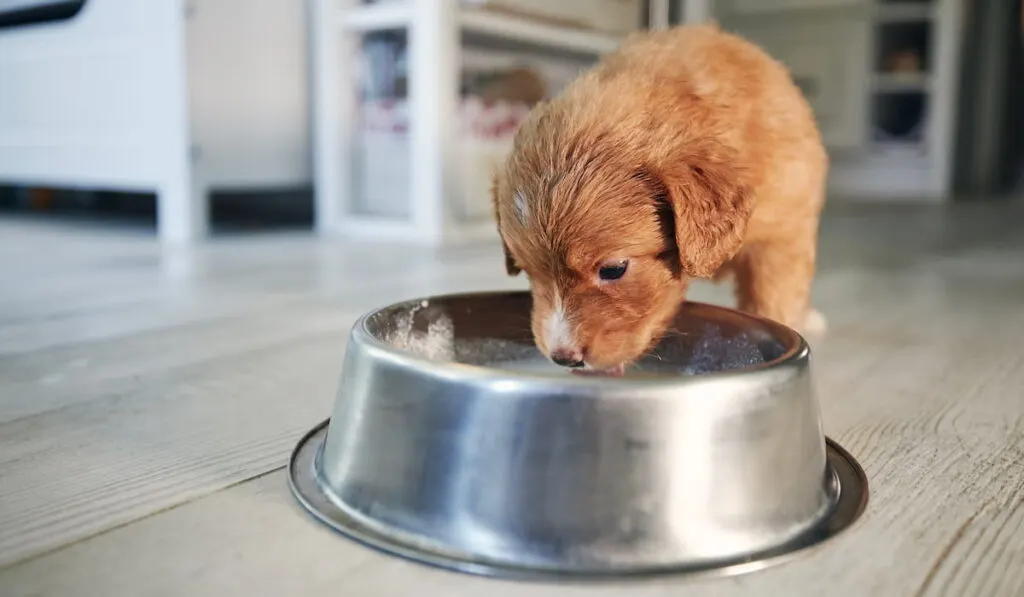
The puppy should be introduced to its food and water bowls so that it knows where it can get access to both. The puppy should also be shown its toys and bed. At this point, it’s usually best to let the puppy rest and not make a huge fuss over it.
Most people do great with their new puppy until the first night comes, and they try to crate the puppy overnight for the first time in a separate room. This can lead to the puppy crying and the owner eventually bringing the puppy into bed with them.
Not only can this be a bad habit to get into, but it can also lead to smaller puppies being accidentally smothered, so definitely confine them to their crate or an enclosed area with their bed at night.
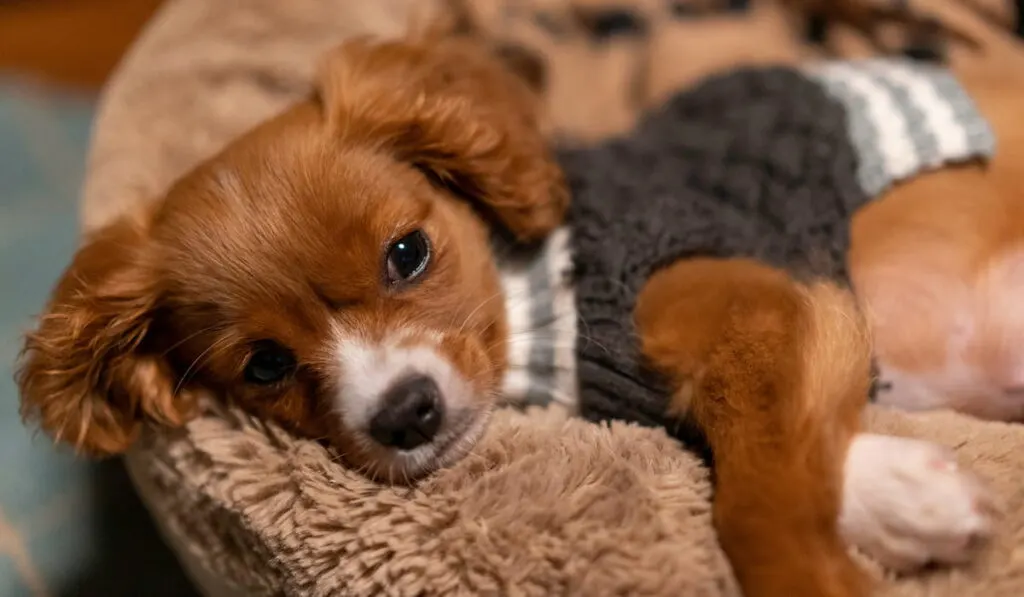
To make sure that a new puppy’s first night is more comfortable, you can place a warm water bottle wrapped in a towel in their bed with them along with a ticking watch or clock.
This ticking noise can help simulate a mother dog’s heartbeat and soothe the puppy to sleep. It’s important not to get up throughout the night to console a crying puppy, or the puppy will learn to cry for attention.
Socializing a New Puppy
One of the most important aspects of having a young puppy in the house is that it needs to be rigorously socialized in the first few weeks of its life, especially from eight weeks through six months of age.
During this formative period, puppies should be exposed to the following stimuli to desensitize them to strange experiences that might cause fearful behavior otherwise:
- People of different ages, ethnicities, and genders
- Loud and random noises such as fireworks
- Thunder, lightning, and rain noises
- Other dogs and animals (under supervision, once vaccinations are underway)
- Different walking surfaces
- Car rides
- Wheelchairs, walkers, and canes
- Darkness
- Being left alone for periods of time
- Large groups of people
- Strange or loud objects such as umbrellas, vacuum cleaners, toys, and household tools
- Water and baths
- Handling (not just being pet and held, but also having paws, ears and mouth handled)
Socializing your puppy by exposing them to these experiences is an excellent way to prevent a wide variety of behavioral problems in adolescent and adult dogs such as fear aggression, separation anxiety, and excessive barking at strange stimuli. For a more in-depth article on properly socializing your young puppy, check out this article here.
Large Breed Puppies vs. Small Breed Puppies
Large breed puppies and small breed puppies require slightly different care, especially when they’re younger than six months old. A major difference in the way the two types of puppies are raised is that the owners of large breed puppies must be careful not to over-exercise their puppies while they are growing to prevent damage to their skeletal systems and joints.

Small puppies don’t have as many skeletal issues to consider while they grow, but some dog breeds have puppies that are so small that they can be easily injured by being stepped on or mishandled by rough children. For this reason, small breed puppies should be crated or gated off when not being directly supervised to avoid any tragic accidents.
Large breed puppies and small breed puppies also require different types of food. Large breed puppies require food that will prevent them from growing too quickly, while small breed puppies need a high-calorie diet to prevent hypoglycemia (low blood sugar), which some small breeds are prone to having. This is especially true for “teacup” sized small breeds such as miniature Yorkshire terriers and Pomeranians.

While it might not seem as vital to train a small breed puppy as it does a large breed puppy, the truth is that no matter what size your puppy is, it will require obedience training. The main reason is to avoid serious behavioral problems and other issues that will decrease your quality time with the dog.
Nutrition for Puppies
A puppy that leaves its mother at eight weeks old should already be weaned onto solid food but may require that the food be moistened with water or puppy milk replacer so that it’s not too hard to chew.
Puppies need a dog food that is specially formulated for them rather than adult dog food, as they require more protein and calories than an adult dog.
Because puppies can only eat so much food in a sitting at first (puppies that are nursing eat in small amounts throughout the day), it is a good idea to feed your puppy small amounts of food two or three times a day rather than feeding them all of their food at one time. Once the puppy begins to grow larger, the number of meals fed can be dropped.

It’s a good idea to get a puppy used to a regular meal schedule when they’re young, as this simplifies housebreaking. A puppy should have restricted access to food while it’s being housebroken but should always have access to fresh water that is changed out daily.
Housebreaking Puppies
There are several methods to housebreaking puppies from puppy pads to training bells, but the most important thing for successfully housebreaking your puppy is to give the puppy consistency. Here are some tips for how to quickly housebreak your puppy:
- Get up in the middle of the night. When puppies are young, their bladders are tiny, and for the first few weeks, it’s highly likely you’re going to need to get up in the middle of the night to take the puppy out if you want to avoid cleaning up accidents. This can be a hassle, but it gets the puppy quickly into the habit of going to the bathroom outdoors only.
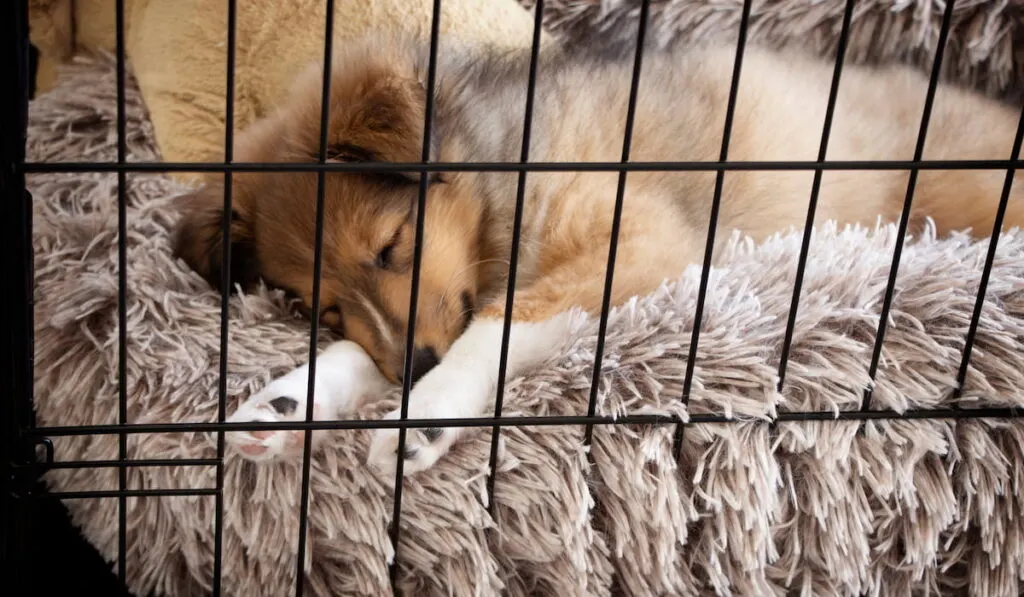
- Provide positive reinforcement and treats for good bathroom behavior. Reward every successful potty trip outdoors with a treat and praise. This will help teach your puppy that going to the bathroom outside is what you want it to do.
- Do not punish your puppy for having an accident indoors. Rubbing a puppy’s nose in its own mess is no different than doing it to an infant human. Puppies don’t choose to have an accident to anger or disappoint their owners and shouldn’t be punished for it. Instead, thoroughly clean any accidents that happen when you’re not watching to prevent repeat offenses.
- Walk your puppy regularly. Short walks encourage puppies to mark their territory and stimulates their bowels, so it’s a good option for getting your puppy to use the restroom outside when just walking it into the backyard doesn’t cut it.
- Follow the ten-minute rule. As a general rule of thumb, puppies will need to pee or poop approximately ten to fifteen minutes after eating, drinking, playing, or sleeping. By observing your puppy, you can learn to take them outside and preempt any housebreaking accidents, which helps to train the dog more quickly.
Training Puppies
From the first day your new puppy comes home, training will be an essential part of your interactions with it. From learning to tolerate a collar and leash to basic obedience commands, training can help your puppy learn to be a well-behaved member of the household. It can also help you bond with your puppy by teaching you to communicate with each other using a common language.
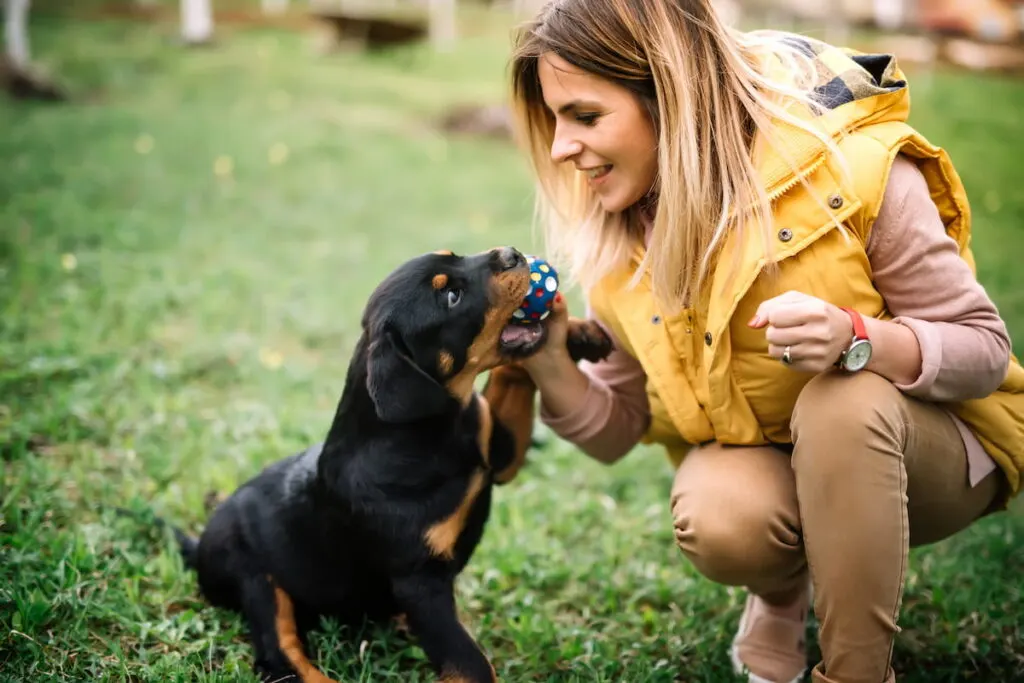
There are two easy ways to accelerate the training of a puppy: positive reinforcement and hand signals. Positive reinforcement is what helps teach your puppy which behaviors the puppy performs that you want them to repeat. Treats and praise also help make training fun and keep the dog interested in what you’re trying to tell it.
When used in conjunction with verbal commands, hand signals can help a dog learn verbal commands more quickly. If hand signals are maintained in obedience training up through adulthood, you can eventually end up with a dog you can tell to stay, be quiet, or lay down without even saying a word.
An excellent way to train puppies in basic obedience commands like sit, down, stay, and heel is to train them in very short bursts of fifteen to twenty minutes. This prevents the puppy from becoming bored, which makes it more challenging to keep them engaged.
Veterinary Care for Puppies
Puppies need to receive regular veterinary care when they’re young. The most important aspect of veterinary care for young puppies is their vaccination schedule.
Puppies need to be vaccinated against rabies by law, but it’s also recommended that dogs be vaccinated against other common illnesses such as parvo, kennel cough, and canine distemper.
Many boarding kennels and veterinary clinics will not allow you to keep your dog there overnight without full vaccinations.
While they aren’t required by law, puppy parvo vaccinations are crucial to preventing a severe illness that is often fatal in young puppies, so it should be undertaken to avoid a senseless tragedy in the household.
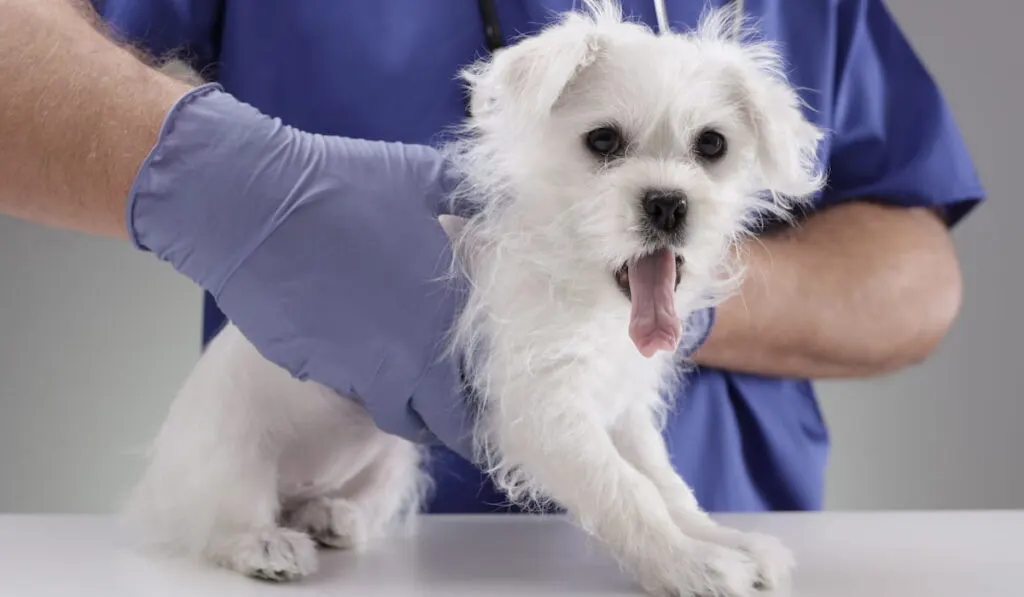
Once your dog has received its puppy vaccinations, it will typically require a rabies booster shot every three years after its initial vaccination schedule to maintain a legal status.
Along with their vaccinations, puppies should also be checked at least twice in the first year to ensure that they are not developing any congenital condition that may negatively impact their health.
Puppyhood to Adolescence
When a puppy is eight weeks old to six months old, it’s still a puppy, but once a puppy hits six months old, it officially hits adolescence. After becoming an adolescent, a once pliable puppy may become rambunctious, defiant, and general display animal versions of a teenager’s attitude. There may be obedience regressions at this point in the dog’s life, or it might begin to exhibit minor behavioral issues.
This is the point in a dog’s life where many untrained dogs are abandoned at animal shelters because they were not adequately trained or socialized as puppies. Once an untrained puppy becomes an adolescent, behaviors that were “cute” in puppyhood (such as heel nipping, barking at strangers, or growling over a food bowl) become potentially dangerous ones.
Adolescent dogs can also develop conflicting behaviors towards dogs of the same and opposite gender, and dogs at this age are more likely to be involved in dog fights or conflicts with other dogs. The better socialized and trained a puppy is before the age of six months, the less likely they will be aggressive or neurotic in their adolescence.
Adolescent Dog Training
Because adolescent dogs are prone to challenging their owners where they wouldn’t as puppies, it’s important to buckle down on obedience training and socialization with adolescent dogs.
Adolescent dogs also tend to have a ton of energy in comparison to puppies, especially dogs that are from working breeds. So it’s crucial to find a constructive outlet for all that pent-up energy so that you can avoid adolescent dog pitfalls like destroyed furniture, giant holes in the backyard, or excessive barking.
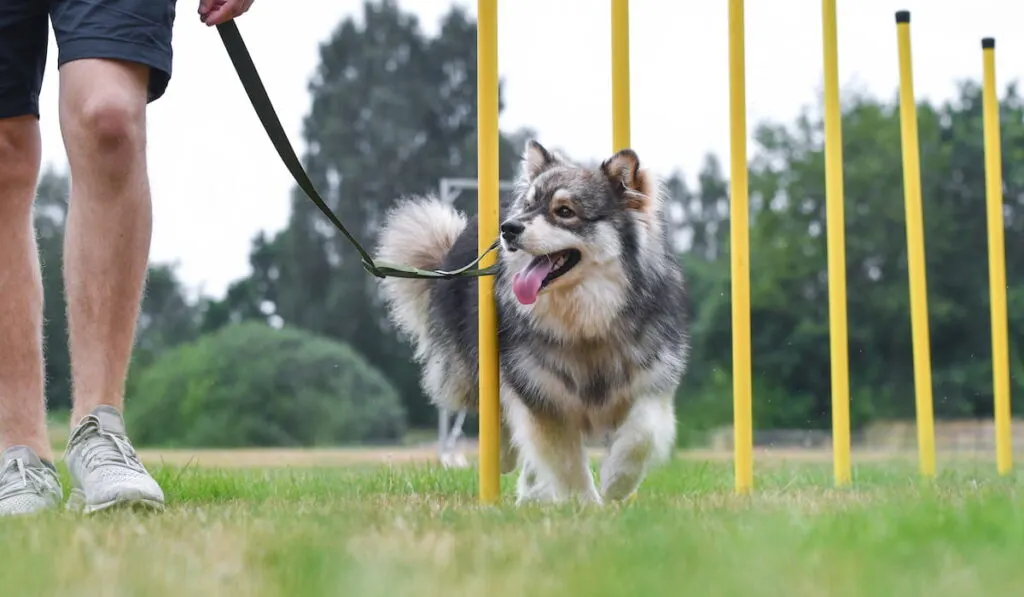
Once dogs have moved from puppyhood into adolescence, if they have received basic obedience training as puppies, this is a good time to move them into more advanced obedience or even agility events such as the following:
- Flyball
- Dock jumping
- Lure coursing
- Carting
- Weight pulling
- Scent work
- Earthdog trials
- Search and rescue
- Therapy work
Even if your dog doesn’t use these skills in a competitive or occupational capacity, training these skills can help keep him or her positively engaged with you. It can help foster a stronger relationship between you and your adolescent dog.
Veterinary Care for Adolescent Dogs
The most critical aspect of veterinary care for adolescent dogs is being spayed or neutered. Each year hundreds of thousands of unwanted dogs are euthanized worldwide due to a lack of suitable homes for them. Spaying and neutering dogs helps to cut down on this excess population of animals and prevents needless deaths.
For those dog owners who have difficulty paying for their spay or neuter surgery, there are many low-income options available throughout the United States that offer this service at a discounted price during certain times of the year to try and combat the pet overpopulation problem.

A dog can be spayed or neutered any time after 8 weeks but you will want to work with your veterinarian to determine the right time for your dog.
Some owners prefer to wait until a female dog has her first heat, but waiting this long leaves a female dog at risk of unwanted pregnancy and can increase their risk of mammary or uterine cancers.
The earlier a male dog is neutered, the less chance there is that he will develop problematic or aggressive behavior towards other male dogs in adolescence.
Some veterinarians prefer not to spay or neuter large breed dogs until they are at skeletal maturity at twelve months. This is because it can cause hormone imbalances that negatively affects the dog’s growth and can leave them vulnerable to bone and joint issue as they become older.
Nutrition for Adolescent Dogs
Once a dog is six months old, it is usually safe to swap them over from puppy food to adult dog food. Continuing to feed puppy food to an adult dog will often cause them to gain weight, as puppy food is deliberately higher in calories than food that is formulated for adult dogs.
Puppy food can be fed through the first year, but the amount should be reduced to avoid excess calories.
As large breed dogs get older, it’s important to elevate their food bowls and make sure that they don’t eat too quickly or too soon after strenuous exercise. This is to prevent gastric torsion or bloat, a severe digestive disorder that can injure or kill many kinds of large breed dogs.
Dogs such as Labrador retrievers and Great Danes are particularly susceptible to bloat. Large dogs should eat from an elevated bowl to prevent bloat. And dogs that tend to gorge on their food and water should be fed in small amounts to avoid overeating or overdrinking too quickly.
The most important aspect of nutrition to provide to adolescent dogs is high amounts of protein, as this is the stage of a dog’s growth after the rapid growth of puppyhood, where it is “filling out” and putting on muscle to pad out its gangly skeletal system.
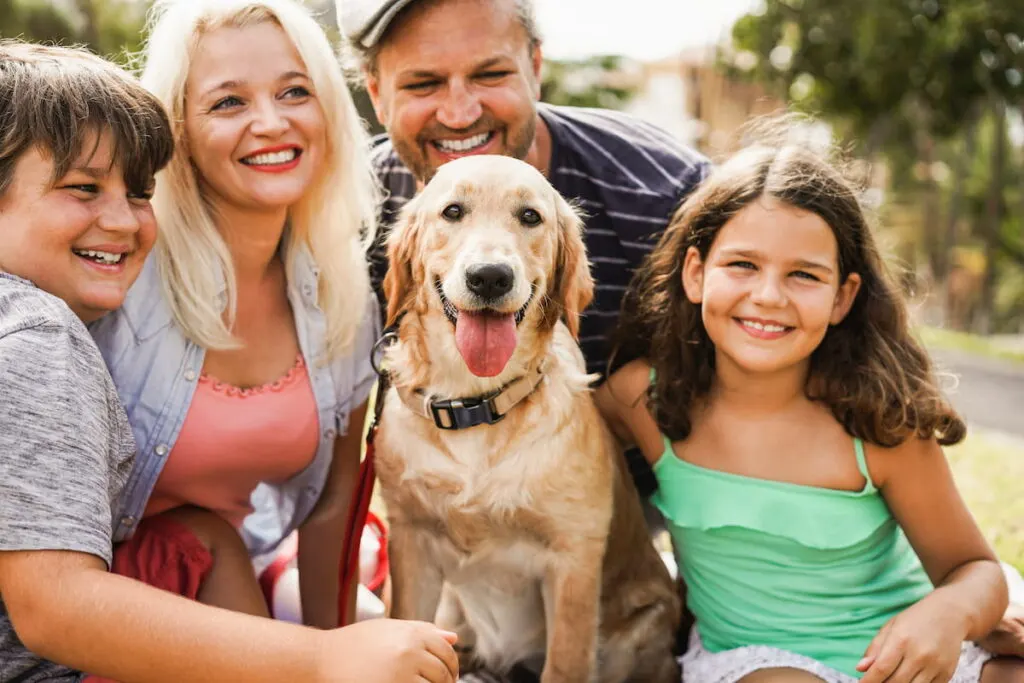
Raise Your Puppy Right, and You’ll Have a Friend for Life
Having the right supplies, veterinary care, and nutrition for raising your puppy are important. Still, possibly the most vital aspect of raising a puppy into a good dog is the amount of time you put into training and bonding with it. Puppies confined to the backyard most of the day without any socialization will likely grow into an adolescent terror. However, a puppy that is truly integrated into daily life will become a calm and steadfast friend.
There are a lot of things to keep in mind when you’re bringing home a new puppy for the first time, but as long as you have some idea of what to expect, you should be able to enjoy your new companion for years to come.
